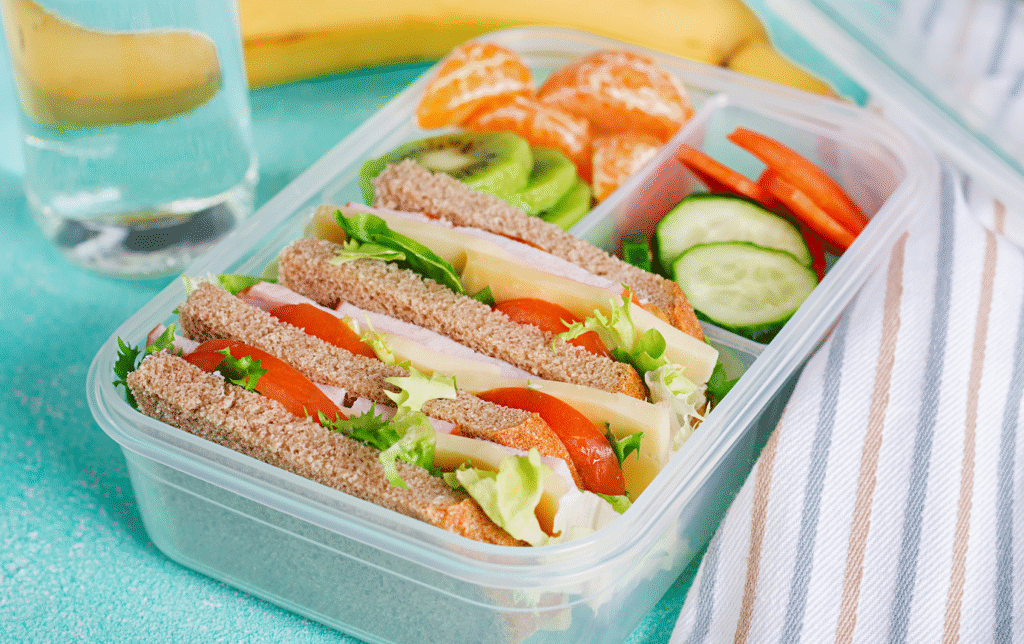
Packing a lunchbox for school-age children is a daily ritual that blends love, creativity, and a touch of strategy. As a parent, I’ve stood in my kitchen at 6 a.m., bleary-eyed, trying to figure out how to make a meal that’s both nutritious and exciting enough for my picky eater to actually enjoy. It’s a balancing act—ensuring the food fuels their growing bodies, keeps them focused in class, and doesn’t end up in the trash can. This blog post dives deep into crafting nutritious lunchbox ideas that are kid-approved, practical, and fun. From expert-backed nutritional advice to creative recipes and time-saving tips, here’s everything you need to pack a lunchbox that your child will love and you’ll feel good about.
Why Nutritious Lunchboxes Matter for Kids
A well-packed lunchbox does more than fill a hungry belly—it sets the tone for a child’s day. According to the Centers for Disease Control and Prevention (CDC), proper nutrition supports physical growth, cognitive development, and emotional well-being in children. School-age kids, typically between 6 and 12 years old, need balanced meals to power through long school days, extracurricular activities, and homework sessions. A nutrient-rich lunch can improve concentration, boost energy, and even enhance mood, helping kids thrive both academically and socially.
But let’s be real: kids aren’t thinking about micronutrients when they open their lunchboxes. They want food that tastes good, looks appealing, and doesn’t make them feel “different” from their peers. The challenge is creating meals that check all the boxes—healthy, tasty, and socially acceptable. This post will guide you through practical ways to achieve that balance, with ideas inspired by my own trial-and-error in the kitchen and insights from nutrition experts.
Building Blocks of a Nutritious Lunchbox
Before diving into specific ideas, let’s break down the components of a balanced lunchbox. According to Harvard T.H. Chan School of Public Health, a healthy meal for kids should include:
- Protein: Supports muscle growth and keeps kids full longer. Think lean meats, eggs, beans, or tofu.
- Whole Grains: Provide sustained energy. Opt for whole-grain bread, brown rice, or quinoa.
- Fruits and Vegetables: Deliver vitamins, minerals, and fiber. Aim for a rainbow of colors to make it fun.
- Healthy Fats: Support brain development. Include avocados, nuts (if allowed), or olive oil-based dressings.
- Calcium-Rich Foods: Essential for strong bones. Yogurt, cheese, or fortified plant-based milk are great options.
The goal is variety and balance. A lunchbox with only carbs or just veggies won’t cut it—kids need a mix to stay energized and satisfied. Let’s explore how to turn these components into meals kids will actually eat.
Creative Lunchbox Ideas Kids Will Love
1. Bento Box Bonanza: Colorful and Customizable
Bento boxes are a game-changer for lunchbox packing. These compartmentalized containers make it easy to include a variety of foods while keeping things visually appealing—a big win for kids. My daughter, Emma, used to push away plain sandwiches, but when I started using a bento box, she couldn’t wait to dig in. The key is to make it colorful and interactive.
Try this Rainbow Bento Box idea:
- Protein: Sliced turkey or hummus with veggie sticks.
- Whole Grain: Whole-grain crackers or a small pita pocket.
- Fruits and Veggies: Cherry tomatoes, baby carrots, sliced strawberries, and blueberries.
- Healthy Fat: A small container of guacamole or a sprinkle of sunflower seeds.
- Fun Extra: A cube of cheddar cheese cut into a heart shape (use a cookie cutter for extra flair).
Bento boxes are also great for portion control and reducing food waste. According to KidsHealth, offering small portions of multiple foods encourages kids to try new things without feeling overwhelmed. Plus, the separate compartments keep soggy sandwiches at bay.
2. Wrap It Up: Fun and Portable
Wraps are a versatile, mess-free option that kids love. They’re easy to hold, customizable, and feel a bit more “grown-up” than a standard sandwich. When my son, Liam, went through a phase of refusing bread, wraps became my go-to. They’re also a great way to sneak in veggies without a fuss.
Chicken Caesar Wrap:
- Spread a whole-grain tortilla with a light Caesar dressing (use Greek yogurt-based for extra protein).
- Add shredded romaine lettuce, grilled chicken, and a sprinkle of Parmesan.
- Roll tightly and slice into pinwheels for a fun presentation.
For a vegetarian option, try a Black Bean and Avocado Wrap:
- Mash avocado with a squeeze of lime for a creamy base.
- Add black beans, diced bell peppers, and a sprinkle of cilantro.
- Wrap it up and cut into bite-sized pieces.
Wraps are endlessly adaptable—swap in whatever protein or veggies your child likes. The Academy of Nutrition and Dietetics recommends using whole-grain wraps to boost fiber, which aids digestion and keeps kids full longer.
3. Skewers and Kabobs: Playful and Nutritious
Kids love food on a stick—it’s fun and feels like a treat. Skewers are also a great way to pack in protein and veggies in a way that doesn’t scream “healthy.” I once made mini fruit kabobs for a school event, and they disappeared faster than the cupcakes!
Turkey and Veggie Skewers:
- Thread cubes of turkey, cherry tomatoes, and cucumber chunks onto small skewers.
- Pair with a side of hummus or a yogurt-based ranch dip.
Fruit Kabobs:
- Alternate grapes, pineapple chunks, and melon balls on skewers.
- Serve with a small container of vanilla yogurt for dipping.
Use blunt-tipped skewers or break sharp ones in half for safety. The USDA’s MyPlate suggests including at least one fruit or vegetable in every meal to ensure kids get enough vitamins and minerals.
4. Mini Muffins: Savory and Sweet Options
Mini muffins are a lunchbox hero—portable, kid-friendly, and perfect for sneaking in nutrients. I started baking savory muffins when Emma refused anything green. By blending spinach into a cheesy muffin batter, I got her to eat veggies without a single complaint.
Cheesy Zucchini Mini Muffins:
- Mix grated zucchini, whole-wheat flour, cheddar cheese, and eggs into a batter.
- Bake in a mini muffin tin for 15–20 minutes at 350°F.
- Pair with a side of sliced apples and a boiled egg.
For a sweet option, try Banana Oat Muffins:
- Blend mashed bananas, oats, a touch of honey, and cinnamon.
- Bake in mini muffin tins for a naturally sweet treat.
The American Academy of Pediatrics notes that whole-grain-based snacks like these provide steady energy without the sugar crash of processed treats.
5. Pasta Salads: Cold and Convenient
Cold pasta salads are a lunchbox staple because they’re easy to prep ahead and taste great at room temperature. They’re also a sneaky way to pack in veggies and protein. My kids love twirling forkfuls of pasta, and I love that I can make a big batch on Sunday for the week.
Pesto Pasta Salad:
- Toss whole-grain rotini with store-bought or homemade pesto.
- Add diced chicken, cherry tomatoes, and mozzarella balls.
- Sprinkle in some spinach leaves for extra greens.
Mediterranean Pasta Salad:
- Mix cooked farfalle with chickpeas, cucumber, feta, and a lemon-olive oil dressing.
- Add a side of grapes for sweetness.
The Mayo Clinic recommends keeping cold foods below 40°F to prevent bacterial growth, so include an ice pack in the lunchbox.
Comparison Table: Lunchbox Ideas at a Glance
Nutritious Lunchbox Options Compared
| Lunchbox Idea | Main Components | Prep Time | Kid Appeal | Nutritional Highlights | Best For |
|---|---|---|---|---|---|
| Rainbow Bento Box | Protein, whole grains, fruits, veggies, healthy fats | 10–15 min | High (colorful, interactive) | Balanced nutrients, fiber | Picky eaters, variety lovers |
| Chicken Caesar Wrap | Protein, whole grains, veggies | 5–10 min | Moderate (fun to eat) | Protein, fiber, calcium | On-the-go kids |
| Turkey and Veggie Skewers | Protein, veggies | 10 min | High (food on a stick!) | Protein, vitamins A & C | Younger kids, fun lunches |
| Cheesy Zucchini Mini Muffins | Whole grains, veggies, protein | 25 min (batch) | High (bite-sized) | Fiber, protein, veggies | Veggie-averse kids |
| Pesto Pasta Salad | Whole grains, protein, veggies | 15 min (batch) | Moderate (pasta is a hit) | Protein, fiber, healthy fats | Busy parents, make-ahead |
This table helps you choose the best option based on your child’s preferences and your schedule. For example, bento boxes are great for kids who love variety, while wraps suit those who prefer handheld meals.
Time-Saving Tips for Busy Parents
Packing a lunchbox every day can feel like a second job, especially when you’re juggling work, school drop-offs, and extracurriculars. Here are some tips to streamline the process without sacrificing nutrition:
- Batch Prep: Spend an hour on Sunday prepping components like boiled eggs, chopped veggies, or a big batch of pasta salad. Store in airtight containers for easy assembly.
- Involve Kids: Let your children pick one item for their lunchbox (within healthy boundaries). My kids are more likely to eat what they’ve helped choose. The National Institute of Health suggests involving kids in meal planning to foster healthy eating habits.
- Use Leftovers: Repurpose last night’s dinner. Grilled chicken can become a wrap, and roasted veggies can go into a pasta salad.
- Invest in Gear: A good lunchbox with compartments and a reliable ice pack makes packing easier and keeps food safe. Look for BPA-free options like those recommended by Consumer Reports.
Addressing Dietary Restrictions and Allergies
Many schools have strict rules about allergens like peanuts, and some kids have dietary restrictions like gluten intolerance or vegetarian diets. Always check your school’s policy before packing nuts or other common allergens. For kids with specific needs:
- Gluten-Free: Swap wheat-based wraps or pasta for rice-based or quinoa-based alternatives. Brands like Banza offer chickpea pasta that’s high in protein.
- Vegetarian/Vegan: Use plant-based proteins like lentils, tofu, or edamame. A hummus and veggie wrap is a great vegan option.
- Dairy-Free: Opt for fortified almond milk yogurt or nutritional yeast for cheesy flavor without dairy.
Consult with a pediatric dietitian if your child has complex dietary needs. The Food Allergy Research & Education (FARE) offers resources for managing food allergies safely.
FAQ: Common Questions About Lunchbox Packing
How can I keep my child’s lunchbox food safe?
Use an insulated lunchbox with an ice pack to keep cold foods below 40°F and hot foods above 140°F, as recommended by the USDA. Pack perishable items like yogurt or deli meats right before leaving the house.
What if my child is a picky eater?
Start with familiar foods and gradually introduce new ones in small portions. Pair a new veggie with a favorite dip like hummus. Involving kids in packing, as mentioned earlier, can also increase their willingness to try new foods.
How do I make lunchboxes budget-friendly?
Buy in bulk (like whole grains or frozen fruits), use seasonal produce, and repurpose leftovers. Avoid pre-packaged snacks, which are often pricier and less nutritious.
Can I pack hot foods in a lunchbox?
Yes, use a thermos to keep foods like soup or pasta hot. Preheat the thermos with boiling water for 5 minutes before adding food to maintain temperature.
How do I make lunchboxes visually appealing?
Use colorful ingredients, cut foods into fun shapes, and include a variety of textures. A small note or sticker can also make the lunchbox feel special.
Conclusion: Packing Love and Nutrition into Every Lunchbox
Crafting a nutritious lunchbox for your school-age child is more than a daily chore—it’s an opportunity to nourish their body, spark their creativity, and show them you care. Whether you’re assembling a vibrant bento box, rolling up a tasty wrap, or baking a batch of veggie-packed muffins, the goal is to create meals that are healthy, delicious, and exciting. By balancing protein, whole grains, fruits, veggies, and healthy fats, you’re setting your child up for success both in and out of the classroom.
Start small: try one new idea from this post each week, involve your kids in the process, and don’t be afraid to experiment. If a lunchbox comes home untouched, ask your child what they liked or didn’t like—it’s a learning process for both of you. Over time, you’ll find a rhythm that works for your family, making lunchbox packing a joyful part of your routine.
For more inspiration, check out resources like Super Healthy Kids for kid-friendly recipes or explore Pinterest for creative lunchbox ideas. Here’s to happy, healthy lunches that fuel your child’s adventures!




